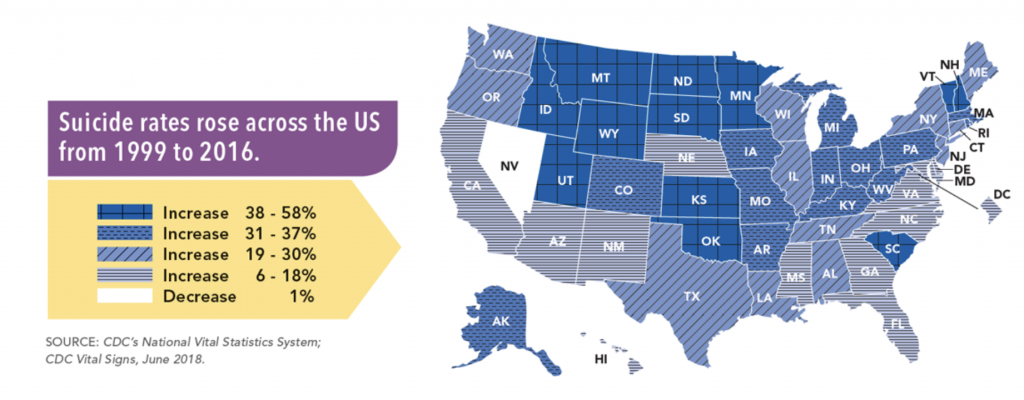 Conversations about suicide in the workplace have been seemingly unavoidable, due to the self-inflicted deaths of apparel icon Kate Spade and Anthony Bourdain, chef, author and “Parts Unknown” host, last week. Employers may use these tragedies to reconsider their own prevention and awareness efforts, and ways they can productively contribute to the dialogue and keep their workers safe.
Conversations about suicide in the workplace have been seemingly unavoidable, due to the self-inflicted deaths of apparel icon Kate Spade and Anthony Bourdain, chef, author and “Parts Unknown” host, last week. Employers may use these tragedies to reconsider their own prevention and awareness efforts, and ways they can productively contribute to the dialogue and keep their workers safe.
According to the latest Vital Signs report by the Centers for Disease Control and Prevention (CDC) (which was released in the time between the two aforementioned fatalities), suicide is the tenth-leading cause of death in the United States and is on the rise. The new data also shows that in 2016, nearly 45,000 Americans age 10 and older died by suicide—equaling about 123 people every day.
The increases were reflected in 49 states (Nevada being the only one with a decrease) and 25 states had rate increases of more than 30% since 1999.
“Suicide is a leading cause of death for Americans—and it’s a tragedy for families and communities across the country,” CDC Principal Deputy Director Anne Schuchat, M.
D. said in a statement. “From individuals and communities to employers and healthcare professionals, everyone can play a role in efforts to help save lives and reverse this troubling rise in suicide.”
Suicide is rarely caused by a single factor, the CDC said. Although suicide prevention efforts largely focus on identifying and providing treatment for people with mental health conditions, there are many additional opportunities for prevention.
Dialogue Etiquette
What we say or don’t say, and how we say it, matters to those struggling with thoughts of ending their lives and to those suffering a loss due to suicide. Suggestions for how to address the issue are offered by CNN, which quoted a crisis intervention expert advocating for changing the phrase “committed suicide.”
“It implies sin or crime” –we “commit” sins and crimes – “and pathologizes those affected. We suggest more objective phrasing, like ‘died by/from suicide,’ ‘ended their life’ or ‘took their life,'” said Dese’Rae Stage, a suicide awareness activist. “If we’re using the right language, if we’re pulling negative connotations from the language, talking about suicide may be easier.”
Ultimately, the CDC suggests that there is no single method that best prevents or reduces suicide. “Rather, suicide prevention is best achieved,” it stated in the technical package, “…across all sectors, private and public.”
Although society’s collective attention span is limited, considering the barrage of headlines emanating from media outlets and overall news fatigue, suicide – like drug use – is a public health concern. It is likely that more stories and facts will emerge in the coming weeks about the CDC’s data, as well as the mindsets of Bourdain and Spade, which will bring the topics into a mainstream dialogue again.
buy amitriptyline online https://galenapharm.com/pharmacy/amitriptyline.html no prescription
The Business Impact
In 2017, the CDC released Preventing Suicide, a technical package containing strategies and approaches to help employers, government and other sectors of society take a comprehensive public health approach to prevention and address the range of contributing factors.
The package also explores the health and economic consequences of suicides and suicide attempts. For example:
- In 2013, suicide cost $50.8 billion in estimated lifetime medical and work-loss costs alone.
- Another study estimated the total lifetime costs associated with nonfatal injuries and deaths caused by self-directed violence to be approximately $93.5 billion in 2013.
- One estimate suggested that 13.2 million (7%) of the U.S. adult population knew someone 12 months prior to the study who had died by suicide.
The technical package suggests that businesses are among the entities that “are in the best position to establish policies and support practices that create protective environments where people live, work, and play.”
Strategies in a reduction or prevention effort include:
Strengthening access and delivery of suicide care. Two approaches include adding/increasing coverage of mental health conditions in health insurance policies and reducing provider shortages in underserved areas and providing safer care through changes in the systems. The CDC states: “Equal coverage does not necessarily imply good coverage as health insurance plans vary in the extent to which benefits and services are offered to address various health conditions.
Rather it helps to ensure that mental health services are covered on par with other health concerns.”
Creating protective environments. This involves fostering a culture characterized by awareness and encourages prosocial behavior (such as asking for help) that should start at the executive level. It also calls for reducing access to lethal means (such as chemicals, weapons and other items that may be available or necessary in the workplace) among those who may be at risk of suicide.
Reducing future and unexpected risks. These include suicide contagion—which can be triggered by continuous, sensationalized or uninformed reporting on the subject. Should your workplace be impacted by a suicide, postvention approaches such as debriefing sessions, counseling and other actions to provide a protective environment can help balance workplace morale and “may reduce survivors’ guilt, feelings of depression, and complicated grief.”
It is worth noting that World Suicide Prevention Day will be observed on Sept. 10, which coincides with National Suicide Prevention Week (Sept. 9-15) in the U.S.
